- Home
- William Goldman
Adventures in the Screen Trade Page 12
Adventures in the Screen Trade Read online
Page 12
Now he may study the format: Does it look like a screenplay? Is it legible or some Xerox that is hard to read and slants across the paper? Finally, he will take a deep breath, turn to the fade-in. And do you know what he wants at that moment?--
--he wants to love it.
Truly. He wants his head knocked off, he's been doing this a long time, thousands of Rocky rip-offs, of Star Wars steals. It's been so long since he's been thrilled by something.
At last he begins to read.
Some screenplays are like Marley--dead to begin with. Westerns. Or disaster films. Or a movie about two octogenarians tending each other through their final days of leprosy. But maybe only five percent of screenplays fall into the Marley category.
But a much larger percentage than that are dead by page 15. Because by then an experienced reader will either be hooked or bored. And if he's bored, he may skip to page 50, read a few more pages, then on to the end, a cursory glance--
--and the ball game's over.
All right, what's a decent beginning for a movie? This is not:
FADE IN ON
NIGHT, A THICK DESERTED WOOD, AND A BEAUTIFUL GIRL running for her life. At least she would be beautiful if her face were in repose--but right now panic distorts her features. She plunges on, the branches of the trees slashing at her clothing. She runs and runs and, with every step, her terror grows. Now, suddenly, she stops, trying to hold her breath as she turns, looks back, listens.
CUT TO
THE WOODS BEHIND HER. For a moment there is nothing--then the unmistakable sound of growls, heavy footsteps.
CUT TO
THE BEAUTIFUL GIRL as she involuntarily shudders, begins to run again as we
HOLD.
THE GIRL IS GONE, we can hear her running on, but now the growls grow louder, the footsteps too and as we watch--
A DISFIGURED GIANT appears, stopping where the girl stopped. His face has been hideously burned. He looks around, growling and then, as the sound of a female cry comes from up ahead, he begins to lumber forward again as we
CUT TO
THE BEAUTIFUL GIRL and she's tripped over a log, fallen heavily, the wind knocked out. One of her legs has been cut and it's starting to bleed. Maybe the sight of the blood spurs her on or maybe she's just a girl with a lot of courage, but she ignores the pain, forces herself to her feet, runs on, only now, if anything, she's going faster than before and the tree branches are really cutting in at her but she ignores it, goes racing through the night as we
CUT TO
THE DISFIGURED GIANT, growling as he moves after her, and he's strong, you can see the power in his body, but with his enormous size there is also something else apparent--a lack of speed and
CUT TO
A TREE BRANCH, whipping across the BEAUTIFUL GIRL'S face, a slice of blood curls down her cheek and it must hurt like crazy but she ignores it, rushes faster than she's ever gone and
CUT TO
THE DISFIGURED GIANT, and maybe he senses he's losing her, maybe not, but he throws his horrid face to the heavens and a wild scream of frustration bursts from him and
CUT TO
THE BEAUTIFUL GIRL, and the sound is audible and it's not close and she keeps on, keeps on and
CUT TO
THE DISFIGURED GIANT, lumbering forward, screaming again at the night and
CUT TO
THE BEAUTIFUL GIRL, and this time the sound is farther back--she's winning, she's winning and she knows it, but all that does is summon more energy and she's never run this fast, never in her life, and for the first time now, briefly, the panic is less, you can see that, and so what if the woods are thick, so what if her leg and her face are bloody, she's got a chance at survival and
CUT TO
THE WOODS, starting at last to thin out, we're coming closer and closer to the edge of the thick trees and
CUT TO
THE DISFIGURED GIANT, slowing, panting, he bangs a great hand against a tree in wild frustration and
CUT TO
THE BEAUTIFUL GIRL as ANOTHER DISFIGURED GIANT appears suddenly in front of her, and this one makes the first one look handsome and
CUT TO
THE BEAUTIFUL GIRL, screaming as the SECOND DISFIGURED GIANT grabs her, raises her high in his hands, throws her to the floor of the woods, and
CUT TO
THE SECOND DISFIGURED GIANT growling in triumph as he falls on her, pins her helpless, and she struggles, tries to twist and kick and
CUT TO
THE FIRST DISFIGURED GIANT, bursting onto the scene--he too drops beside the BEAUTIFUL GIRL, and as they commence to rip at her clothes--
DISSOLVE TO
It matters not where we dissolve, I suspect our world-weary executive has already closed the script and reached for the next in his endless pile.
Why? I mean, what's so terrible about these pages? It's got action, suspense, shock, mystery, blah blah blah.
Well, among other things, it's television.
This paragraph contains all that I know about writing for television. They need a hook. And they need it fast. Because they're panicked you'll switch to ABC. So tv stuff tends to begin with some kind of grabber.
But in a movie, and only at the beginning of a movie, we have time. Not a lot, but some.
Time to set up our people.
Time to set up our situation.
Time, if you will, to set up our particular world.
As I sit here I can only think of one first-class modern novel, movie, or play that begins at full speed, and that's Malraux's Man's Fate. Clearly there must be others, but not all that many, which perhaps underscores the point: In narrative writing of any sort, you must eventually seduce your audience. But seduce doesn't mean rape.
Here's another beginning that makes a mistake of a different sort, but one no less uncommon:
FADE IN ON
CENTRAL PARK. New York City. A glorious spring dawn.
CUT TO
A COUPLE OF JOGGERS, moving quickly along. Ahead of them is a hill and they start up it, then stop dead, staring, and as they do--
CUT TO
THE TOP OF THE HILL AS FIFTY CAMELS come roaring over the crest of the hill, bearing down on the joggers.
More than likely, our studio executive will stop right there. He may even pitch the screenplay across the room. Why? I mean, it's kind of an interesting visual, fifty camels racing across the Sheep Meadow. You certainly don't sit there and say, "Oh Christ, here's another goddam Central Park camel opening."
And probably, if instead of Central Park the movie began in the Sahara, the executive would read on.
Or if the script was written say, by Woody Allen, he would most certainly continue. Because Allen is a pro, and he understands the realities of the picture business. If he wants fifty camels in Central Park, there must be a valid reason, a payoff somewhere down the line. But few of us are Woody Allen.
And this is an amateurish beginning.
Do you know what would more than likely go through the executive's mind when he read that? Something like this: "Fifty camels? Where are we going to rent them? And for how much? And where are we going to train them to run in a pack? And who's going to do the training? And for how much? And how do we get the goddam things to New York? What's the going rate on camel shipping? And once we get them there, is the city going to give us a permit? For fifty camels? In Central Park? Is this writer crazy?" And there would go your screenplay flying across the room.
When you write something, if the picture happens, someone must actually go about executing the details of the script. Hardworking technicians, like yourself. So if you get a flight of fancy that entails a sudden snowstorm blanketing Honolulu airport, there better be a good reason. A crucial reason. Because that is not an easy thing to recreate.
And movies are not made by elves and fairies....
Having now shown you what I consider to be a rotten beginning and an amateurish one, it would be nice if I could write you a good one. But sin
ce I'm never quite sure what "good" means, the best I can do is put down what I think is the classiest opening I've done--one that, by the way, was never shot. The notion came from a recurring flying dream that the director, George Roy Hill, had as a child.
This was the start of The Great Waldo Pepper. (Waldo, remember, was the story of these daredevil flyers in the twenties, grown-up children who wanted to impress girls and be heroes and fly.)
FADE IN ON
THIS KID. Maybe he's ten, freckled and bright-eyed. Very American-looking. And we're in CLOSE UP, so we don't know where we are or when, but that doesn't matter; what matters is that the KID is concentrating on something just as hard as he can. He's staring off and biting his lip and
CUT TO
A TEN-YEAR-OLD GIRL. CLOSE UP. And there are a lot of boys who are going to lose a lot of sleep over this one when she gets a little older. She's looking up at something just now, we don't know what yet, but she's so excited you can feel the pounding of her heart. Now--
CUT TO
THE BOY. Not quite so close up this time. He takes half a step forward, then hesitates, stops, and begins kind of to rock back and forth, nervously back and forth as we
CUT TO
THE TEN-YEAR-OLD GIRL, AND NOW ANOTHER GIRL THE SAME AGE JOINS HER. This one is pretty, too, and she, too, stares up at the same angle, and she's just as excited as her friend, and they stand there, side by pretty side, watching and waiting, watching and waiting.
CUT TO
THE BOY. He takes a deep breath, slowly starts running forward, and as he does
CUT TO
THE TWO PRETTY GIRLS, and whatever's going on, it's just too exciting, they simply can't stand it and, keeping their eyes on the running BOY, they reach for each other's hands, find them, clutch each other tightly as we
CUT TO
THE BOY, running faster now, picking up speed as he tears across this enormous hill, coming closer and closer to the edge of it, and beyond that edge there's one hell of a sheer drop-off but that doesn't seem to matter, because now the BOY is going all out and the edge is just ahead and
CUT TO
THE GIRLS, watching, clinging to each other, their eyes wide, going wider and now
CUT TO
THE BOY, suddenly extending his arms out like wings, launching himself off the edge of the cliff and
CUT TO
THE GIRLS, waving joyously as the BOY soars over them, changes his arm position, banks, flies back over them a second time, waves down, then starts to climb as the GIRLS continue to stare up at him, their eyes filled with wonder.
CUT TO
THE COUNTRYSIDE AS THE BOY SOARS ALONG and, Jesus, it's beautiful up there, green and sunlit and pure and now
CUT TO
A DIFFERENT BOY, SOARING THROUGH SPACE.
CUT TO
A DIFFERENT GIRL WATCHING THAT DIFFERENT BOY, but that same look of dreamlike wonder is in her eyes, too, and
CUT TO
STILL ANOTHER BOY, running along the roof of a barn, and when he reaches the edge he, too, starts to fly and
CUT TO
ANOTHER BOY, poised in a treetop, but only for a second, and as he glides into space
CUT TO
THE SKY, and it's full of flying children.
CUT TO
THE GROUND and the GIRLS are there, beautiful, awed, waiting and
CUT TO
THE SKIES AGAIN, and now the BOYS are starting to come in from unexpected angles, soaring up from the bottom, zooming in from the corners, and the GIRLS are clapping and waving and crying and everything's going faster, getting more and more wild, it's all reaching a peak now, and the GIRLS just love it, they do, you can see it in their eyes as they watch their heroes and the flying dream is perfect, and no one ever crashes, not ever, not once, not here, not now....
After this there was the sound of a motor and we dissolved to Waldo flying into town, as he does now in the movie.
Why did I like that? It's hard to remember for sure, but I guess I thought it was original. And unexpected. And also, in a weird way, logical--
--I thought it set up the world.
Because the barnstorming pilots were just adolescents nourishing a heroic fantasy that World War I had taken away. And what this sequence was intended to do was show the daydream at its best: girls, glory, freedom, etc. I still think it does.
George Hill disagreed, and this opening was gone by either the second or third draft. I suspect I argued for it, but you can only do that for so long: If your director either has no faith in a sequence or just plain won't shoot it, it usually doesn't end up on the silver screen.
My memory is that George felt the fantasy clashed with the reality that was to follow. Plus, he had shot a lovely sequence in The World of Henry Orient where the two teen-age heroines go careening around New York in slow motion, jumping high over things, floating.
Another opening I wrote that wasn't used was for All the President's Men. I'll describe what it was briefly, but first let me explain why I wrote it.
When I began researching the Woodward-Bernstein book, before it was published, it seemed, at best, a dubious project. Politics were anathema at the box office, the material was talky, there was no action, etc., etc. Most of all, though, people were sick to fucking death of Watergate.
For months, whenever anyone asked me what I was working on, and I answered, there was invariably the same reply: "Gee, don't you think we've heard enough about Watergate?" Repeated often enough, that can make you lose confidence.
Because, of course, we had. Heard enough and more than enough. Years of headlines, claims and disclaimers, lies, and occasional clarifying truths.
I decided my best shot was to try and surprise people.
So I opened, intentionally, with the most cornball shot in the world--the Washington Monument lit up at night. Then another totally predictable shot--the Watergate complex, also at night. Then inside the building to the Democratic National Committee offices and a bunch of men, quietly and expertly, starting the famous breakin.
I truly hoped at this point the audience would be groaning. "What are we doing here for chrissakes? We know it all already."
The robbery went on, tautly and expertly in silence--only they had the wrong keys. They goofed and had to leave the place, frustrated and angry.
The reason I opened that way was because people didn't know it all. The famous breakin was either the third or fourth attempt, and what I wanted was to have people suddenly looking at each other and thinking, "Hey, maybe I better pay attention, there's stuff here I hadn't heard about."
The opening was never shot because the movie always had a length problem and the feeling was we didn't need the red herring to start off with. And that was a very sound decision. If the original opening had been incorporated, and you looked at it today, I think you would wonder what the hell it was doing there.
At the time, though, at least in theory, it had a purpose. To set up a world, a world in which there would be traps and surprises.
In a sense, a screenplay, whether a romance or a detective story, is a series of surprises. We detonate these as we go along. But for a surprise to be valid, we must first set the ground rules, indicate expectations.
And that's what beginnings are all about....
Endings
Near the conclusion of North by Northwest, Cary Grant finds himself in something of a pickle.
His true love, Eva Marie Saint, is dangling helplessly in space on the face of Mount Rushmore. If she falls, splat. The reason she has not fallen is that Grant is holding her with one hand while with the other he grabs a rock ledge. Not easy. Watching all this is Martin Landau, the subvillain, who stands a few feet away, holding the precious statuette that contains valuable microfilm inside, said microfilm being of great danger to America should it fall into enemy hands. Grant, desperate, looks up at Landau and asks for help.
Landau walks over to Grant and, instead of bending down and aiding him, puts his foot o
n Grant's fingers and begins pressing down. He grinds his shoe down as hard as he can.
That's the pickle.
Now, between that moment and the end of this superb Ernest Lehman-Alfred Hitchcock collaboration, the following occurs.
(a) Landau is made to cease and desist.
(b) Grant saves himself.
(c) Grant also saves Eva Marie Saint.
(d) The two of them get married.
(e) The microfilm is saved for America.
(f) James Mason, the chief villain, is captured and handed over to the authorities.
(g) Grant and Saint take a train ride back east.
That's a lot of narrative to be successfully tied up. And I would like you to guess how long it takes in terms of screen time for it to be accomplished. Got your guess? Here's the answer--
--forty-three seconds.
Here's how they do it, from the moment where Landau is crunching Grant's hand. The camera's in close up on the shoe and the fingers. A shot rings out. The shoe begins to slide away from the fingers. Next a cut of the statuette falling safely to the ground and cracking, revealing the microfilm inside. Now Landau falls to his death off Mount Rushmore. Now another part of Mount Rushmore, where Leo G. Carroll, a good guy, thanks a police officer who is holding a rifle. Behind Carroll is Mason, flanked by more officers. Now back to Grant and Eva Marie, him saying you can do it, her saying I can't, back and forth, quick cuts between them, and then a really brilliant shot of Grant pulling her up, only now he's not on Mount Rushmore, he's in the upper berth of a train, and he brings her to him, calls her "Mrs. Thornhill"--Thornhill being his last name, so we know they're married now--and as they embrace, a final shot of the train roaring into a tunnel as The End flashes on the screen.
I don't know a more adroit ending to a film.
Lehman wrote it that way for two reasons. "All the essentials were on the screen. And there was so much unexplained that the one shot of Leo Carroll and Mason and the authorities took care of. People might have asked, 'How did Leo Carroll get there? How did he find the authorities? How did they capture Mason?' If we had had more, it would have made us vulnerable to looking like an entire grocery shelf of open cans of peas."

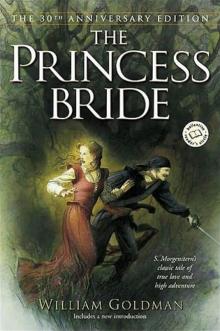 The Princess Bride
The Princess Bride The Temple of Gold
The Temple of Gold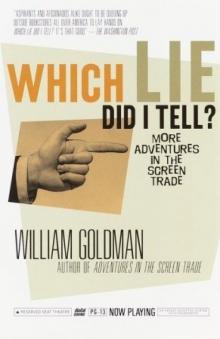 Which Lie Did I Tell?: More Adventures in the Screen Trade
Which Lie Did I Tell?: More Adventures in the Screen Trade Adventures in the Screen Trade
Adventures in the Screen Trade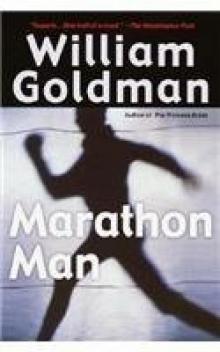 Marathon Man
Marathon Man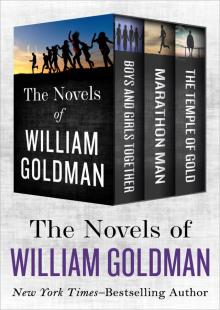 The Novels of William Goldman: Boys and Girls Together, Marathon Man, and the Temple of Gold
The Novels of William Goldman: Boys and Girls Together, Marathon Man, and the Temple of Gold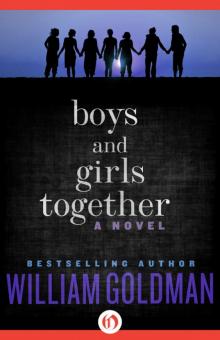 Boys and Girls Together: A Novel
Boys and Girls Together: A Novel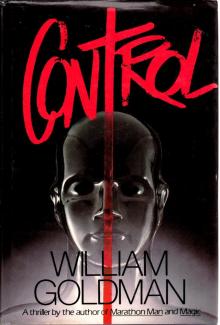 Control
Control The Novels of William Goldman
The Novels of William Goldman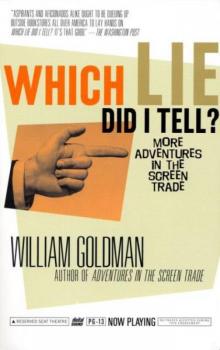 Which Lie Did I Tell?
Which Lie Did I Tell?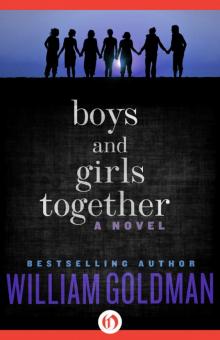 Boys & Girls Together
Boys & Girls Together